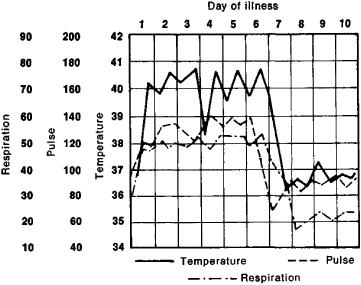fever
(redirected from deer fly fever)Also found in: Dictionary, Thesaurus, Medical, Wikipedia.
fever
Fever
a protective-adaptive body reaction in higher animals and man, expressed in the abnormal elevation of body temperature, which developed during the course of evolution.
In the past, all illnesses accompanied by high temperatures were called fevers. Although modern science shows that fevers are not independent diseases, the names of a number of diseases have retained the term (as, for example, in Q fever, phlebotomus fever, and metal fume fever). Fever is the reaction of the thermoregulatory apparatus to those macromolecular substances, called pyrogens, that affect the chemoreceptors. Pyrogens are classified as either exogenous, that is, entering the body from without (for example, microbes and the products of their life activities), or endogenous, that is, formed in the body itself (for example, products secreted by leukocytes in the process of phagocytosis or substances that appear as a result of damage to the cell-tissue structure).
The temporary reorganization of the regulatory mechanism of heat exchange in order to maintain the higher body temperature (as, for example, in the retention of the capacity to regulate temperature at a new level during muscular work or temperature fluctuations in the external environment) distinguishes fever from thermoregulatory disturbance, such as hyperthermia.
A special form of fever is the elevation of temperature when there has been extraordinary irritation of the sensory nerve endings in a number of organs (bile ducts, gall bladder, urethral canal) or damage to certain sections of the central nervous system (mechanical damage to the hypothalamic region). Elevated temperature is sometimes also observed to accompany mental disturbances. Although it is impossible to identify temperature changes with fever fully in all cases, the character of such changes is in many ways similar to that of fever.
There are three stages in the course of a fever: the rise, the leveling off, or acme, and the fall. In the first stage, heat production

(thermogenesis) exceeds heat loss, mainly because of a decrease in the latter; in the second stage, equilibrium is established between heat formation and heat loss, the thermal balance shifting to a new, higher level; in the third stage, heat loss exceeds heat formation, mostly because of a sharp intensification in the former (see Figure 1). The fall in temperature in the third stage can occur gradually (lysis) or abruptly and rapidly (crisis). A critical fall in temperature, as a result of a concomitant abrupt dilation of the peripheral vessels, can lead to acute vascular insufficiency, or collapse.
When there is fever, the activities of all organs and systems are reorganized and the metabolism is altered. This is due not only to the elevated body temperature but also to the pathogenesis of the primary disease. In addition, the decomposition of proteins and the oxidation of carbohydrates and fats are intensified, and water and certain electrolytes tend to be retained in the body. Respiration and the rhythm of heart contractions are accelerated. In the first stage, the peripheral vessels are constricted; in the second and third stages, they are dilated. Glandular secretion in the digestive tract is suppressed. Disturbances of the activity of the central nervous system may be observed with particularly high fevers.
Fever is classified, according to the degree of temperature rise, as subfebrile (increases to 37.1°–37.9°C), moderate (38°–39.5°C), high (39.6°–40.9°C), and hyperpyretic (41°C and higher; in man, to 42°C). During the second stage, the fever may be characterized as continued, where daily fluctuations do not exceed 1°C (for example, with lobar pneumonia; see Figure 2); remittent, with daily fluctuations as great as 2°C (for example, certain forms of tuberculosis); intermittent, with falls during the daily minimum to normal or below normal; or hectic, with daily fluctuations as great as 3°–4°C (for example, with sepsis or severe, progressive tuberculosis). A disturbance of the diurnal temperature rhythm (a rise in temperature in the morning hours and a decrease in the evening) is characteristic of a perverted, atypical fever.

Fever stimulates the immune processes and suppresses the action of the infectious agent. For this reason, artificially induced fever is sometimes used in medical practice (for example, in the fourth stage of syphilis, with schizophrenia, and with epidemic encephalitis).
REFERENCES
Veselkin, P. N. Likhoradka. Moscow, 1963.Mnogotomnoe rukovodstvo po patologicheskoi fiziologii, vol. 2. Moscow, 1966.
V. A. FROLOV